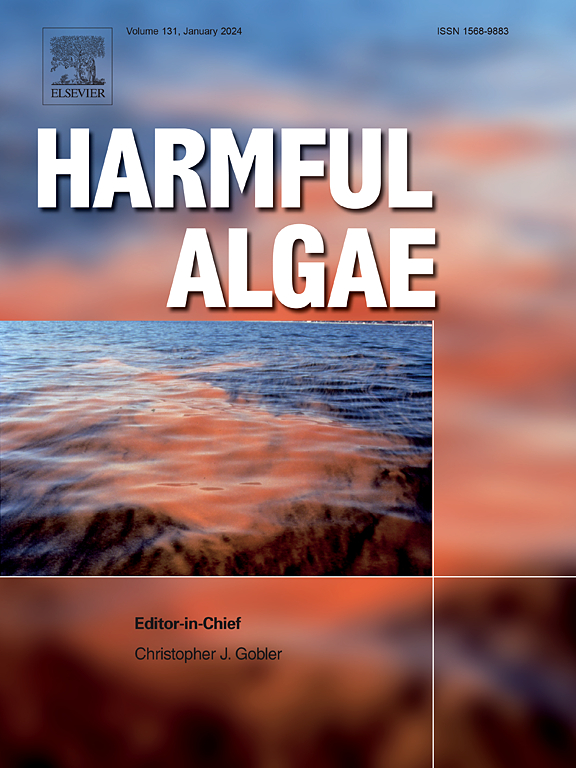Effects of the salinity on the growth, hemolytic activity, fatty acid content, and expression of polyketide synthase and fatty acid synthase genes of Amphidinium carterae (Dinophyceae)
IF 5.5
1区 生物学
Q1 MARINE & FRESHWATER BIOLOGY
引用次数: 0
Abstract
The benthic dinoflagellate Amphidinium carterae can produce fatty acids and polyketide compounds, such as amphidinols. Commonly, polyketides are produced by polyketides synthase (PKS), and fatty acids are produced by fatty acids synthase (FAS). The PKS and FAS genes in dinoflagellates share a common evolutionary history. This study aimed to investigate the effect of five salinities (20, 25, 30, 35, and 40 ‰) on growth, fatty acid content, hemolytic activity, and the expression of PKS and FAS genes. The results showed that low salinity (20 ‰) induces low growth in A. carterae. Cell size was affected by salinity, with a decrease in cell size with the salinity increase. The content of fatty acids and hemolytic compounds content increased at low salinities (20 and 25 ‰). The gene expression of the PKS genes was upregulated at high salinities (35 and 40 ‰) and downregulated at low salinities (20 and 25 ‰); FAS genes were downregulated at high (40 ‰) and low (20 ‰) salinities. The low growth rate at low salinity (20 ‰) and the high content of fatty acids and hemolytic compounds in low salinities (20 and 25 ‰) indicate that low salinities caused stress in this strain of A. carterae. The hemolytic activity at salinity of 20 ‰ probably due to a combinatory effect of high content of polyunsaturated fatty acids and amphidinols. To understand the relationship between gene expression and amphidinols biosynthesis requires the analysis of single-domain and multi-domain PKS.

盐度对甲藻生长、溶血活性、脂肪酸含量及聚酮合成酶和脂肪酸合成酶基因表达的影响
底栖甲藻amphidiinium carterae能产生脂肪酸和多酮类化合物,如两栖酚。通常,聚酮由聚酮合成酶(PKS)产生,脂肪酸由脂肪酸合成酶(FAS)产生。鞭毛动物的PKS和FAS基因具有共同的进化史。本研究旨在探讨5种盐度(20、25、30、35和40‰)对海鱼生长、脂肪酸含量、溶血活性以及PKS和FAS基因表达的影响。结果表明,低盐度(20‰)对黄杨生长有抑制作用。细胞大小受盐度的影响,随着盐度的增加,细胞大小减小。在低盐度(20‰和25‰)时,脂肪酸含量和溶血性化合物含量升高。PKS基因在高盐度(35‰和40‰)下表达上调,在低盐度(20‰和25‰)下表达下调;FAS基因在高(40‰)和低(20‰)盐度下下调。低盐度(20‰)下生长速率低,低盐度(20‰和25‰)下脂肪酸和溶血化合物含量高,表明该菌株在低盐度下受到胁迫。盐度为20‰时的溶血活性可能与多不饱和脂肪酸和两性酚的高含量共同作用有关。为了了解基因表达与两性酚生物合成之间的关系,需要分析单结构域和多结构域PKS。
本文章由计算机程序翻译,如有差异,请以英文原文为准。
求助全文
约1分钟内获得全文
求助全文
来源期刊

Harmful Algae
生物-海洋与淡水生物学
CiteScore
12.50
自引率
15.20%
发文量
122
审稿时长
7.5 months
期刊介绍:
This journal provides a forum to promote knowledge of harmful microalgae and macroalgae, including cyanobacteria, as well as monitoring, management and control of these organisms.
 求助内容:
求助内容: 应助结果提醒方式:
应助结果提醒方式:


